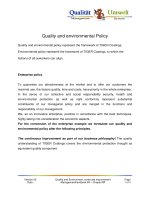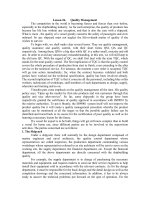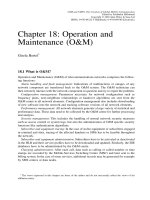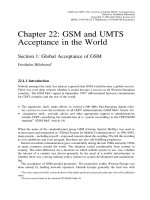Tài liệu Product and Brand Management doc
Bạn đang xem bản rút gọn của tài liệu. Xem và tải ngay bản đầy đủ của tài liệu tại đây (408.04 KB, 16 trang )
Product and Brand Management:
What is marketing?
Marketing is an organizational function and a set of processes for creating,
communicating, and delivering value to customers and for managing customer
relationships in ways that benefit the organization and its stakeholders. The process
through which VALUE is exchanged.
What is a product?
Anything that can be offered to a market for attention, acquisition, use, or
consumption that might satisfy a need or want.
Product Essentials:
• Product features and benefits
• Packaging
• Branding
• Warranties and guaranties
• Time to market
• Lifecycles
Levels of product
Core product
Actual product
Augmented product
Product Items, Lines, and Mixes
Product Item- a specific version of a product that can be designated as a distinct
offering among an organization’s products.
Product Line- a group of closely related product items.
Product Mix- all products that an organization sells.
Product Strategy
Defines what the organization does and why it exists. It Involves creating a product
offering that is a bundle of physical (tangible), service (intangible), and symbolic
(perceptual) attributes designed to satisfy customer’s needs and wants. It Strives to
overcome commoditization.
Innovators represent the first 2.5 percent of all individuals who ultimately
adopt a new product. They are more venturesome than later adopters, more
likely to be receptive to new ideas, and tend to have high incomes, which
reduces the risk of a loss arising from an early adoption.
Early adopters represent the next 13 to 14 percent who adopt. They are more a
part of the local scene, are often opinion leaders, serve as vital links to
members of the early majority group (because of their social proximity), and
participate more in community organizations than do later adopters.
Product Life Cycle
Introduction Growth Maturity
Decline
Post
Mortem
Loss/profit
Time
$
Sales
Sales
Profit
Profit
Progression of product “life” stages (sales & time)
Diffusion of Innovations
Source: Rogers, Everett M, Diffusion of Innovations, 4
th
ed. (New York: Free Press, 1995)
The early majority includes 34 percent of those who adopt. These individuals
display less leadership than early adopters, tend to be active in community
affairs (thereby gaining respect from their peers), do not like to take
unnecessary risks, and want to be sure that a new product will prove
successful before they adopt it.
The Late majority represents another 34 percent. Frequently, these
individuals adopt a new product because they are forced to do so for either
economic or social reasons. They participate in community activities less than
the previous groups and only rarely assume a leadership role.
Laggards comprise the last 16 percent of adopters. Of all the adopters, they
are the most “local.” They participate less in community matters than
members of the other groups and stubbornly resist change. In some cases,
their adoption of a product is so late it has already been replaced by another
new product.
New Product Development:
The development of original products, product improvements, product modifications,
and new brands through the firm’s own R&D efforts Or New products can also come
from acquisition of other companies, patents, or licenses
Idea Generation-Sales force, Customers, Employees, R&D specialists, The
competition, Suppliers, Retailers, Independent inventors.
Screening-Screening separates ideas with commercial potential from those that
cannot meet company objectives.
Business Analysis-The business analysis consists of assessing the new product’s
market potential, growth rate, likely competitive strengths, and compatibility
of the proposed product with organizational resources.
New Product Development Process
Development-Converting an idea into a physical product Requires interaction
among many of the firm’s departments. Prototypes may go through many
changes.
Test Marketing-Introduction of a trial version of a new product supported by
a complete marketing campaign to a selected city of television coverage.
Commercialization- is stage, the firm establishes marketing strategies,
and funds outlays for production and marketing.
Attributes Associated with a Product Offering
• What is Brand?
A brand is a person’s gut feeling about a product, service or organization.
l A brand defines the relationship customers have with us.
l A brand is a promise we make to our customers
and to ourselves.
l A brand is shaped by each experience customers have with the firm.
• A brand differentiates the product from similar offerings.
Traditional view: A brand is a name, term, sign, symbol, or design which is intended
to identify the goods or services of one seller or group of sellers and to differentiate
them from those of competitors.
Recent views:
Brand is what is experienced and valued by customers in everyday social life.
Brand is the culture of the product- shared, taken-for granted brand stories,
images and associations.
Brand is the emotional file we have for a product or a service or entity.
A brand is a seller’s promise to deliver consistently a specific set of features,
benefits and services to buyers.
For customer brand is an experience
Role of Brand:
Signify quality
Create barriers to entry
Serve as a competitive advantage
Secure price premium
How Brand works?
Level-1: Identification-Brand name and logo ensure the product can be recognized
and distinguished from the competition.
Level-2: Security- You get what you expect.
Level-3: Added value- individual “laddered” benefits.
Level-4: Transformation-the brand actually invokes change in the consumer.
Brand: A brand is a mixture of attributes, tangible and intangible, symbolized in a
trademark, which, if managed properly, creates value and influence.
• Branding:
The purpose of branding is to transform a product. Transforming a commodity like
product into customer satisfying value added propositions is the essence of branding.
BRANDING IS A:
A physical product is combined with something else- symbols, images and feelings to
produce an idea or concept. The two grow with and live on one another in a mutually
enhancing partnership.
• Branding is “emotional product development”.
Two routes of brand building:
1. from product advantage- intangible values
2. from values-products
• Promotion is the vehicle that allows us to access the consumer’s mind, to create
a perceptual inventory of imagery, symbols and feelings that come to define
the perceptual entity “we call a Brand.”
The Brand and Value
The brand is a focal point for all the positive and negative impressions created by
the buyer over time as he comes into contact with the brand’s products, distribution
channel, personnel and communication...
The value of a brand comes from its ability to gain an exclusive, positive and
prominent meaning in the minds of a large number of consumers” (Kapferer 1997,
pg. 25).
What is brand equity?
The differential effect that brand knowledge has on consumer response to the
marketing of that brand.
The unique “brain space” that your brand occupies in the minds of your
customers.
Brand equity is defined in terms of the marketing effects uniquely attributable to the
brand.
Brand image: A strong brand Image is created by marketing programs that link
strong favorable and unique associations to the brand in the memory.
Brand image reflects the linking of strong, favorable and unique associations to the
brand in memory.
Four steps in building brand equity:
1. Who are you?
2. What are you?
3. What about you? What do I think or feel about you?
4. What about you and me?
Non-Product-Related
(e.g., Price, Packaging,
User and Usage
Imagery)
Non-Product-Related
(e.g., Price, Packaging,
User and Usage
Imagery)
Product-Related
(e.g., color, size,
design features)
Product-Related
(e.g., color, size,
design features)
Functional
Functional
Symbolic
Symbolic
Experiential
Experiential
Attributes
Attributes
Benefits
Benefits
Overall
Evaluation
(Attitude)
Overall
Evaluation
(Attitude)
Types of
Brand Associations
Types of
Brand Associations
Favorability,
Strength, and
Uniqueness of
Brand Association
Favorability,
Strength, and
Uniqueness of
Brand Association
Brand
Recognition
Brand
Recognition
Brand
Recall
Brand
Recall
Brand
Awaren
ess
Brand
Awaren
ess
Brand
Image
Brand
Image
Brand
Knowle
dge
Brand
Knowle
dge
Sources of Brand Equity









